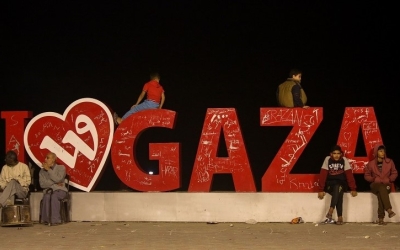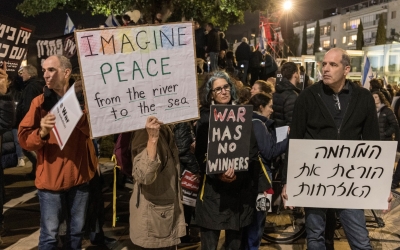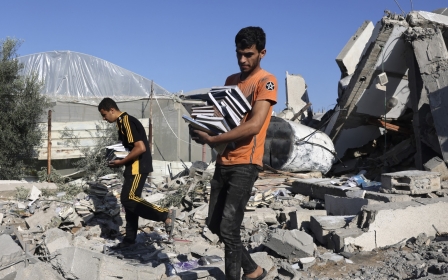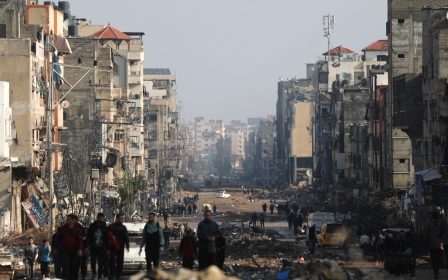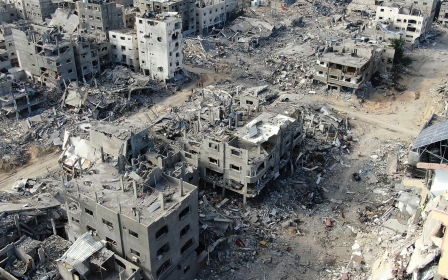War on Gaza: How Israel killed Palestinians waiting for food trucks in northern Gaza
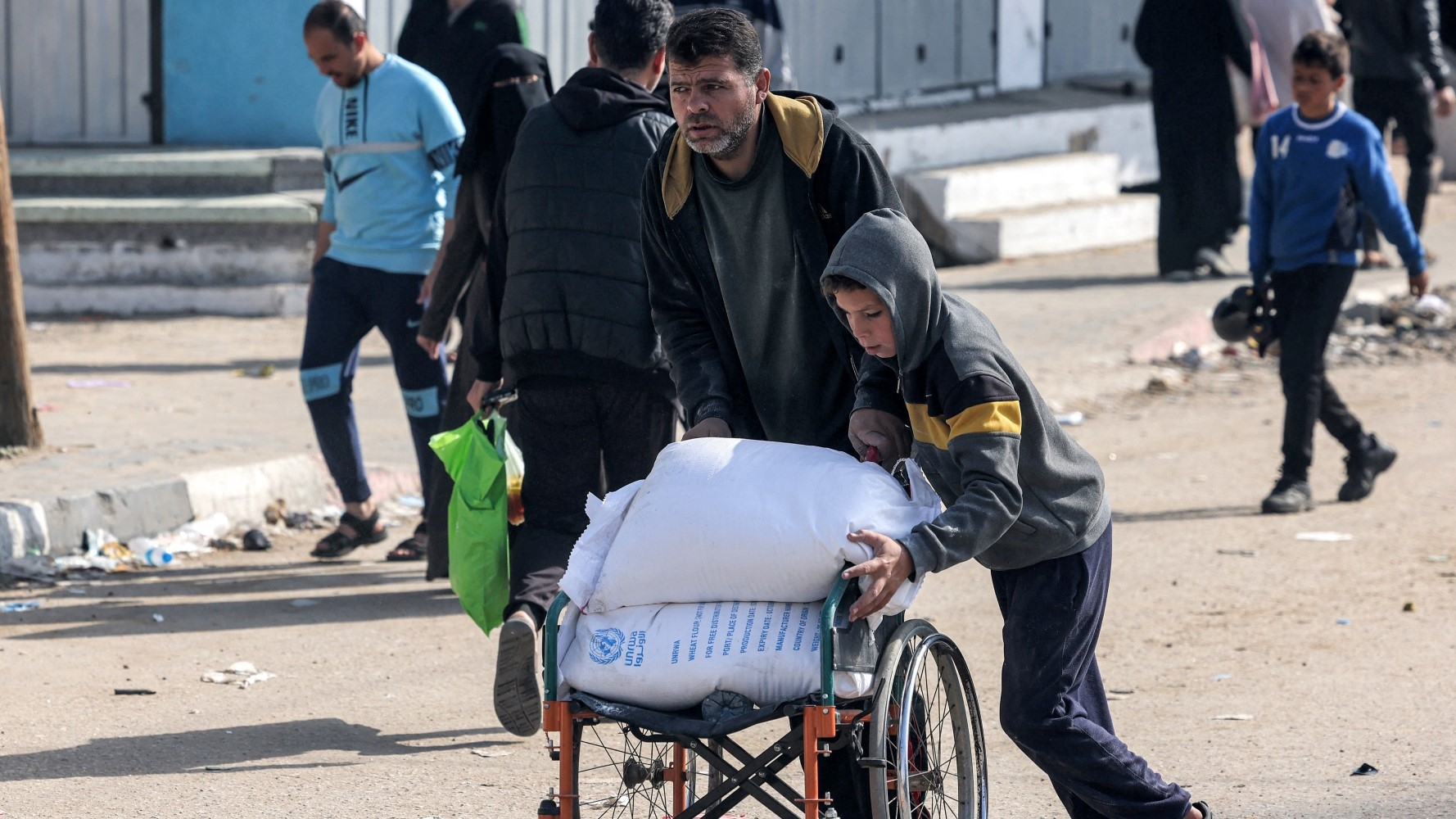
It was supposed to be a place where displaced Palestinians gathered for desperately needed supplies of food in northern Gaza.
But eyewitnesses have told Middle East Eye how on 11 January a large crowd waiting for a food truck on al-Rasheed Street came under fire from the Israeli military, with dozens killed and wounded in the attack.
The Israeli military shelled the crowd with tank fire and quadcopters. Muhammad Al-Salim, 27, witnessed the massacre, telling Middle East Eye that he saw scores of bodies strewn across the street.
“At 9am me and my two cousins went to Al-Rasheed street after people in our area told us that trucks carrying flour were going to pass by,” he recalled.
“We arrived there at 10am because most of the streets were destroyed and filled with rubble, so cars could not pass.
“When we arrived at Al-Rasheed street, there were already hundreds of people waiting there.
“As we crossed the Nabulsi roundabout, an Israeli army tank appeared from behind a sand hill and started shooting at the people randomly.
“At the same time, quadcopter planes started attacking us and the hundreds of people, including children, around us.”
Salim says he saw two girls in front of him hit by bullets and the people at the front of the line shot and killed by tanks and quadcopters.
He added that he saw upwards of 50 dead and wounded, with hundreds of people in the crowd fleeing into the narrow streets adjoining Al-Rasheed to avoid the hail of bullets and shells.
'I saw two girls running by the truck to get some flour, they ran so hard but were caught under the truck. They died immediately'
- Muhammad Al-Salim
Despite the killings, Salim returned to the scene along with scores of others when the aid trucks eventually arrived at around 11:30am.
He saw six trucks in total, four carrying flour and canned goods, while the other two carried medicine.
“Many people returned to await the trucks as we did , despite their injuries and the dead bodies around us. They were trying to catch the trucks, to make sure they got some food for their families,” he said.
“I saw two girls running by the truck to get some flour, they ran so hard but were caught under the truck. They died immediately,” he added.
‘The scene was horrifying’
Salim's account is also corroborated by other witnesses, including 27-year-old Ahmed Abed.
On the morning of 11 January, Abed and his brother gathered with a group of youths and headed to Al-Rasheed street at 7:30am after hearing that he could buy flour there.
He knew it would be a risk, but the food trucks were affordable compared to locally sourced flour.
Like Salim, when he got to the Nabulsi roundabout, his journey took a turn for the worse.
After reaching the landmark near the Gaza coast, he joined a large group of people he assumed were also heading for the aid trucks.
'I saw people being shot and falling dead next to me'
- Ahmed Abed
“Suddenly and without any provocation or warning, shooting started coming from where the aid and flour trucks were expected to arrive,” he recalled.
“At the same time, quadcopter planes appeared above us and started indiscriminately shooting at all of us,” he added.
“The scenes were horrifying, I saw people being shot and falling dead next to me.”
Abed said that he could hear the bullets whizz past him and even fall to the ground near him.
He made his way to the ruins of houses alongside Al-Rasheed street, darting across rubble heaps, unable to think of anything besides getting away from the bullets.
“I was so scared I forgot about my brother and the guys who were with me.”
After continuing to walk for a few hundred metres, he managed to regroup with some of his friends and return to his neighbourhood.
His father had been waiting anxiously with others in the community for the men return.
Two of Abed's group were seriously wounded, including one who got shot in his neck and another in his hand.
“We were looking for flour,” Abed said. “I will never go back to get flour again, even if I starve to death.”
‘The shooting started suddenly’
For the people of Gaza, hunger is now a daily reality and while no part of the besieged territory is safe from Israeli attacks, for people in the north the threat is most pervasive.
Living amongst rubble and with a meagre diet, the choice they must confront is whether to stay within their shelters hoping they can make food last as long as possible, or risk death by venturing out to find aid trucks.
Mahmoud Hamdi, 33, lives with his wife and four children in Gaza City and since the war started they have been joined by Hamdi’s parents and his brother with his family of three, because their homes have been destroyed.
“We eat one meal a day, mostly rice or lentils, so we can preserve whatever foods we have,” he told Middle East Eye.
When he heard that aid trucks would be arriving near Al-Rasheed street on 11 January, he decided to make the journey there in the hope of getting some food supplies.
“I knew that the road might be dangerous, but I decided to go because I had no other choice, ” he said.
"My children have been asking me constantly to bring food, and have been telling their mother that they were so hungry. I couldn't bear to see my kids suffering in fear and starvation.”
Initially Hamdi felt safe joining the crowds at Al-Nabulsi roundabout, thinking that Israel would not fire into such a large gathering of civilians. But then the shooting started.
“I saw many people shot and falling to the ground, dying,” he recalled.
“There were no ambulances around and no one could do anything because the shooting started suddenly and people were running in chaos and fear.”
Hamdi said he saw locals who had arrived with donkey-drawn carts to pick up flour, instead using their carts to ferry the dead and injured away from the shooting.
Others, who had cars, also used their vehicles as makeshift ambulances.
“I froze,” Hamdi said. “I started crying because I was unable to react or run away. I didn’t know what to do.”
When he managed to come to his senses, Hamdi ran but a bullet grazed his foot as he did so.
He described the wound as “superficial” and so continued running away from the gunfire, as his foot bled.
“I returned home later that day without getting any flour or food for my kids,” he said.
“Had I known that getting aid would mean a massacre, I would have never gone.
“I thanked God I was able to return, this time around.”
Editor's note: Names have been changed to protect the identities of interviewees
This article is available in French on Middle East Eye French edition.
Middle East Eye delivers independent and unrivalled coverage and analysis of the Middle East, North Africa and beyond. To learn more about republishing this content and the associated fees, please fill out this form. More about MEE can be found here.


